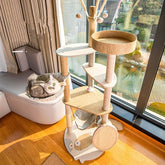Understanding Your Cat's Excessive Crying: Causes, Solutions, and Professional Insights
Table of Contents
- Key Highlights:
- Introduction
- The Nature of Cat Vocalizations
- Understanding the Causes of Excessive Crying
- Misconceptions About Cat Vocalizations
- When to Call the Vet
- Practical Tips for Managing Excessive Crying
- Expert Insights: Vet Q&A Section
- Smart Pet Parent Tip 🐾
Key Highlights:
- Excessive crying in cats can indicate various underlying issues, including medical problems, stress, or behavioral needs.
- Key symptoms to observe include constant vocalization, restlessness, and changes in appetite or grooming habits.
- Early veterinary consultation is crucial for addressing severe or unexplained crying to ensure your cat's health and well-being.
Introduction
Caring for a cat comes with its share of joys and challenges, one of which is deciphering their complex vocalizations. For many pet owners, the sound of a cat crying incessantly can evoke feelings of concern and confusion. What’s causing this distress? Is it a sign of pain, a need for attention, or something more serious? Understanding the reasons behind your cat's vocalizations is crucial for providing the right care and ensuring their happiness. This article delves into the various factors that may lead to excessive crying in cats, offers practical advice for pet owners, and highlights when it's necessary to seek veterinary assistance.
The Nature of Cat Vocalizations
Cats have developed a rich array of vocalizations to communicate with humans and other animals. From the soft purr to the aggressive hiss, each sound has a distinct meaning. Meows, in particular, are a primary way for cats to express their needs and emotions. However, an uptick in vocalization—especially in the form of crying—can be a cause for concern.
Common Symptoms and Behaviors
When your cat begins to cry frequently, it's essential to look for accompanying symptoms that can help identify the underlying issue. Here are some common signs to monitor:
- Constant Meowing or Yowling: Excessive vocalization that seems urgent or distressing.
- Pacing or Restlessness: Cats may display anxious behavior, moving around more than usual.
- Changes in Appetite or Grooming Habits: A sudden decrease or increase in eating or grooming can indicate distress.
- Increased Aggression or Clinginess: Some cats may become more demanding of attention or exhibit signs of irritability.
- Visible Signs of Distress or Discomfort: Pay attention to changes in body language, such as flattened ears or a tucked tail.
These behaviors can provide valuable insight into your cat's emotional and physical state.
Understanding the Causes of Excessive Crying
Several factors can contribute to a cat's excessive crying. Understanding these causes can help you respond appropriately:
Medical Issues
One of the most concerning reasons for a cat crying frequently is the presence of medical issues. Pain, illness, or injury can cause a cat to vocalize more than usual. Conditions such as arthritis, dental problems, or even infections can lead to discomfort that manifests as crying. If your cat is also displaying symptoms such as lethargy, vomiting, or diarrhea, a visit to the veterinarian is crucial.
Stress and Anxiety
Cats are sensitive creatures that can experience stress due to changes in their environment. Moving to a new home, the introduction of new pets, or loud noises can all contribute to anxiety. Cats may cry to express their discomfort with these changes.
Attention-Seeking Behavior
Some cats learn that crying elicits a response from their owners. If they receive attention, food, or playtime following their cries, they may continue this behavior as a means of getting what they want.
Aging and Cognitive Decline
As cats age, they may face cognitive decline, similar to dementia in humans. This can lead to confusion and increased vocalization. Older cats might cry more, especially at night, due to disorientation.
Loneliness and Boredom
Cats are social animals that require mental and physical stimulation. A lack of interaction can lead to boredom, prompting excessive meowing as a call for attention. Providing enrichment through toys, climbing structures, and interactive play can help alleviate this issue.
Misconceptions About Cat Vocalizations
Pet owners often hold misconceptions about why their cats meow. A common belief is that cats only vocalize when they are hungry. While hunger can prompt a meow, cats utilize their vocalizations to communicate a range of needs and emotions. Understanding the context of your cat’s cries is essential for accurate interpretation.
When to Call the Vet
Recognizing when your cat's crying warrants veterinary attention is critical. Here are some signs that should prompt a visit to the vet:
- Accompanied Symptoms: If crying is accompanied by lethargy, vomiting, or diarrhea, it could indicate a serious medical issue.
- Sudden Changes: A sudden onset of excessive crying, particularly in an otherwise healthy cat, may require immediate investigation.
- Persistence: If crying does not improve with changes in the environment or behavioral interventions, professional consultation is necessary.
Practical Tips for Managing Excessive Crying
As a responsible pet owner, there are several strategies you can implement to help your cat manage their crying.
Provide Mental and Physical Stimulation
Engage your cat with toys that encourage play and exploration. Interactive playtime, puzzle feeders, and climbing structures can help keep your cat occupied and satisfied.
Establish a Routine
Cats thrive on routine. Establishing consistent feeding, playtime, and grooming schedules can create a sense of security, reducing anxiety and excessive vocalization.
Consult with Your Vet
If you suspect that your cat's crying stems from a medical issue, scheduling a veterinary appointment is essential. A thorough examination can rule out health problems and provide peace of mind.
Assess Environmental Factors
Consider any changes that might be affecting your cat’s behavior. Loud noises, new pets, or changes in household dynamics can all contribute to stress. Identifying and mitigating these factors can help ease your cat's anxiety.
Use Positive Reinforcement
Encouraging desired behaviors through positive reinforcement can be effective. Reward your cat for quiet behavior with treats or affection, helping to discourage excessive crying.
Expert Insights: Vet Q&A Section
Q: Why is my cat crying all the time?
A: Excessive crying can be a sign of pain, illness, stress, or a need for attention. Observing your cat's overall behavior and consulting with a veterinarian can help identify the cause.
Q: How can I help my cat stop crying?
A: Addressing the root cause is crucial. This may involve medical treatment, making environmental changes, or applying behavioral modification techniques.
Q: Is it normal for cats to cry at night?
A: Nighttime crying can be common, particularly in cats experiencing loneliness, boredom, or anxiety. Ensuring a comfortable sleeping environment and engaging in interactive play before bed can help minimize this behavior.
Q: Should I ignore my cat’s crying?
A: Ignoring cries may inadvertently reinforce the behavior. It’s essential to address the underlying cause while providing comfort and reassurance to your cat.
Q: Can cats cry tears like humans?
A: While cats produce tears to lubricate their eyes, they do not cry emotional tears as humans do. Excessive tearing may signal a medical issue requiring veterinary attention.
Q: How do I know if my cat is in pain?
A: Signs of pain can include changes in behavior, vocalization, grooming habits, appetite, and mobility. If you suspect your cat is in pain, contact your veterinarian for a thorough evaluation.
Smart Pet Parent Tip 🐾
Remember to be attentive to your cat’s cries and behavior. Identifying the underlying causes can guide you in providing the appropriate care and comfort. Consult your veterinarian to address any medical or behavioral concerns contributing to your cat's distress.
Conclusion
Understanding your cat's excessive crying is a vital component of responsible pet ownership. By recognizing the signs, identifying potential causes, and implementing effective strategies, you can significantly improve your cat's quality of life. Whether it's addressing medical concerns, ensuring emotional well-being, or enriching their environment, proactive steps can make a difference. Keeping an open line of communication with your veterinarian and being attuned to your cat's needs will foster a healthier and happier feline companion.





